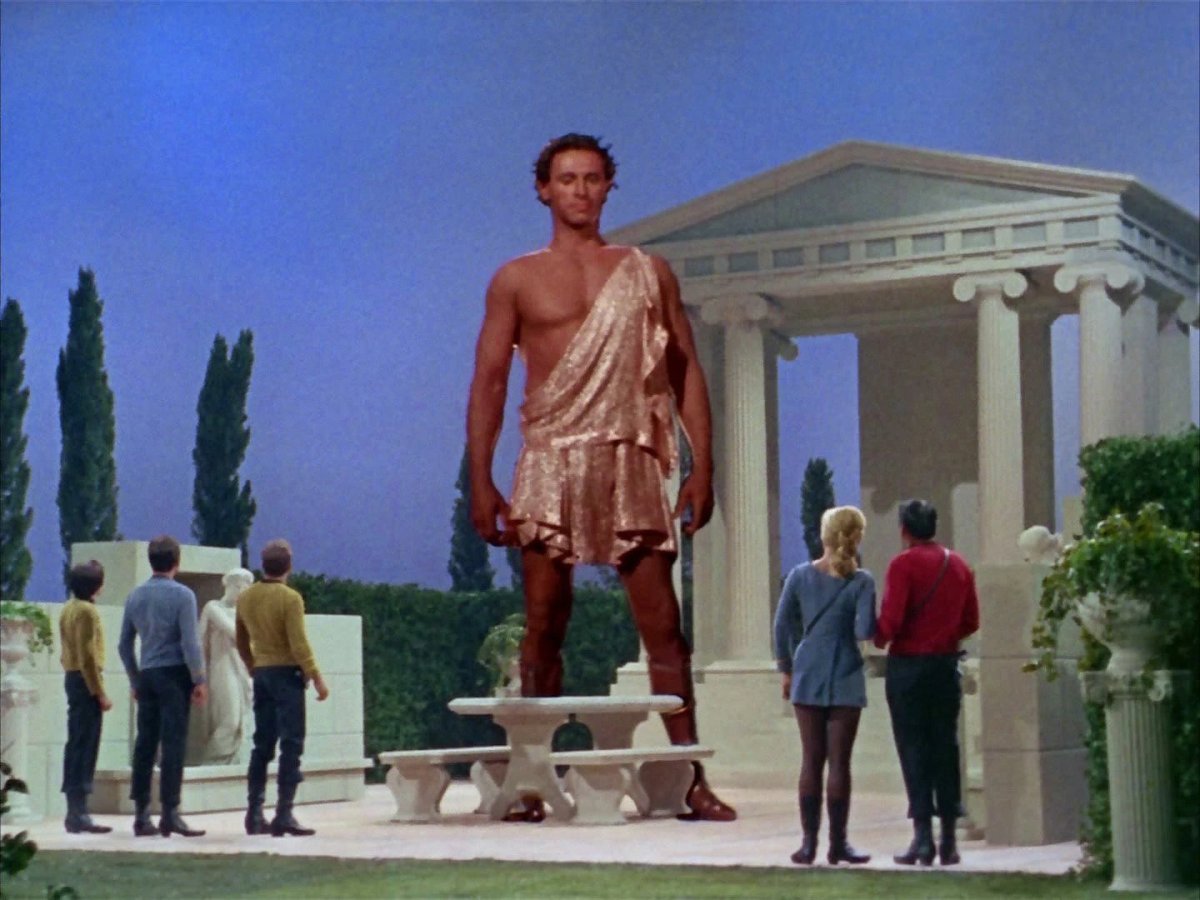★★★1/2 September 22, 1967 Season 2 Episode 2
If you want to see where we are…and you missed a few…HERE is a list of the episodes in my index located at the top of my blog.
This show was written by Gene Roddenberry and Gilbert Ralston
I thought this was a good episode of the series. Thought-provoking, very well-written, and well-paced, with a nice balance of attention paid to the various performers.
Kirk and his crew are waylaid by a powerful alien who claims to be the ancient Greek god Apollo. Apollo demands they abandon their ship and become his worshipers like the Greeks of old Earth had been, and Apollo is not taking no for an answer. The crew has to figure out how to escape his clutches without falling victim to his extraordinary powers and his violent temper.
The idea that the ancient gods were, in fact, visiting aliens is interesting and has been used many times since however here it seems like a way to make an apparently all-powerful being a bit more interesting. Lt. Palamas, we can guess that she will somehow be important in this episode and indeed she is as she appears to fall for Apollo.

The speech that Kirk gives to Palamas was brilliant, I thought. A great piece of rhetoric that is strongly moving, and is potent enough to induce her to betray her heart and act for the good of her fellow humans.
In the end, the combined efforts of Kirk and the landing party on the planet and Spock back on the Enterprise work independently to sort out the challenge. This episode is a great one for Chekov…a very good introduction to him.
From IMDB:
.The title is taken from Adonais: An Elegy on the Death of John Keats by Percy Bysshe Shelley. Line 415 reads “Who mourns for Adonais?”. Shelley’s Adonais is derived from Adonis, a male figure of Greek mythology associated with fertility. Also, “Adonais” would be the English plural of the Hebrew Spoken Name of God (the Hebrew word ‘adonai’ simply means ‘lord’), so it would mean “Who Mourns for the Gods?”
In the original script, the gods and other mythological figures were mentioned in their Latin names, but, in the revised final draft (and the finished episode), they are called by their Greek equivalents (possibly at the suggestion of series researcher Kellam de Forest).
The producers were looking for someone with an English dialect and Shakespearean theatrics to pull off the Apollo role. First, they wanted to find someone in England, but rather decided to look for an actor at the San Diego Shakespeare festival. The head of the theatre recommended Michael Forest, who was already in Hollywood, making films at the time. Forest was called in for an audition, where he first had to take off his shirt, to let them see if he had the muscles needed for the part. Next, they asked him to read some lines in a British accent. Forest refused, claiming he couldn’t do it, but is able to speak in a Mid-Atlantic accent, probably more suitable for the character. He did it, and they gave him the role.
Michael Forest recalled working with his co-stars, “Leslie Parrish was a delightful person to work with; no problems; never any difficulties; we would just discuss what we were going to do and we would do it. She was excellent and very personable. William Shatner was a bit of a problem, however. You never saw me standing with him; we were always in different shots. We would be talking to one another, but we wouldn’t be on camera at the same time. I’m sure that’s what he stipulated – because I was so much taller.”
William Shatner was so concerned with the height disparity that he disallowed any shots which would show him and the much taller Michael Forest side-by-side in the same frame. According to Forest, whenever Shatner would speak to him, Forest would notice Shatner inadvertently standing on his tip toes.
This is the very first episode of Star Trek (1966) (in broadcast order) to feature all seven members of the original cast – including Walter Koenig who was the last to join the cast at the very beginning of Season 2.
Apollo’s temple was constructed on an indoor studio set. Swaying trees (courtesy of hidden stagehands) and dubbed-in bird sounds were combined with stock footage of an outdoor lake and adequately conveyed the illusion of being outdoors.
The fused, charred phaser Kirk holds up as he is speculating about Apollo visiting Earth is the one crushed by Khan Noonian Singh in Star Trek: Space Seed (1967).
This is the first time Kyle is shown in an officer’s uniform (colored shirt, black pants) instead of the noncommissioned officer’s and enlisted man’s jumpsuit. He must have been exceptional since he has jumped past Ensign and Lieutenant Junior Grade to full Lieutenant.
The gown Leslie Parrish wore was glued to her skin to keep it in place, which was painful for her because it tore her skin when it was removed.
In the trailer, the phasers fired by the Enterprise at the temple are blue. In the episode itself, they are red. They would once again be blue in the remastered version of this episode.
This is the only time in TOS that a star is both referred to as its Bayer designation and ancient name, specifically Beta Geminorum aka Pollux.
This was released in 1967. Erich von Däniken published theories concerning ancient aliens coming to earth and being taken for gods due to their advanced technology being witnessed by early humanity only in 1968.
Michael Forest reprised his role as Apollo in the fan-made sequel Star Trek Continues: Pilgrim of Eternity (2013) 46 years later.
This is the first episode, in broadcast order, to feature Chekov’s Russian pride. When Apollo identifies himself, Chekov says “I am the Czar of all the Russias!” Later, after Chekov notices Apollo is fatigued and disappears, Chekov says “He disappeared like that cat in the Russian story…”
The producers originally wanted Jon Voight for Apollo, but he was hired for another project.
A traveling matte was used to allow a giant Apollo to appear with the landing party in the foreground at the end of act one.
Marc Daniels cited this episode as his favorite among those he directed, claiming “it all came together so well”.
Michael Forest and Leonard Nimoy had played brothers on Laramie: The Runt (1962). They also worked together on the play and television adaptation of Deathwatch (1965).
The scene in which Apollo flips Scott to the side was actually executed by stunt double, Jay D. Jones, who was wearing a special harness with which he was pulled backward on cue. Jones nearly slammed into a step prop which could have caused serious injury.
Jason Alexander cites this episode as his favourite of the original series, describing it as “thought-provoking, beautiful, and very sad.”
Summary
The Enterprise is stopped dead in its tracks by a powerful energy force that appears in the form of a human hand. Soon, a being claiming to be Apollo orders Kirk (William Shatner) and several others down to the planet below. Apollo (Michael Forest) claims to have visited Earth 5,000 years ago and Kirk theorizes that he may be telling the truth. Apollo’s demand for unquestioned servitude, however, doesn’t give the crew much choice and it becomes imperative that they locate and destroy his power supply.
CAST
William Shatner … Captain James Tiberius ‘Jim’ Kirk
Leonard Nimoy … Mister Spock
DeForest Kelley … Doctor Leonard ‘Bones’ McCoy
Michael Forest … Apollo
Leslie Parrish … Lt. Carolyn Palamas
James Doohan … Lieutenant Commander Montgomery ‘Scotty’ Scott
George Takei … Lieutenant Hikaru Sulu
Nichelle Nichols Nichelle Nichols … Lieutenant Nyota Uhura
Walter Koenig … Ensign Pavel Chekov
John Winston … Lieutenant Kyle
Bill Blackburn … Lieutenant Hadley (uncredited)
Roger Holloway … Lt. Lemli (uncredited)
Eddie Paskey … Lieutenant Leslie (uncredited)



Appolo has some nice tricks.
LikeLiked by 1 person
I liked this one, in the I guess the Gods need someone to look up to them.
LikeLiked by 1 person
I liked it better the more times I watched it. Interesting concept.
LikeLiked by 1 person
I like a bit of old myth tossed into the mix, ever since I watched, enthralled ‘Jason And The Argonauts.’ Ray Harryhausen made magic come alive on the screen for this kid in short pants, sitting in the fraying faded cheap seats at the Hoyts Ozone in Enfield.
LikeLiked by 2 people
I love that movie as well…that is the first movie that I realized what great effects can do also.
LikeLiked by 1 person
another interesting concept. I think ancient ‘gods’ being extraterrestial aliens was the whole basis of that ‘Chariots of the Gods’ book that was big when we were kids and a chunk of the ‘Ancient aliens’ TV show.
LikeLiked by 1 person
The idea makes sense.
LikeLike
IT’S ABOUT TIME TOS HAD A BIT OF CHEESECAKE FOR THE LADIES. Michael Forest has the ideal male form imo. I love the concepts in this episode. Who is to say that ETs didn’t visit earth and because of their advanced powers be regarded as Gods. I can imagine gods who are used to being idolized who find themselves in isolation would feel lonely and tormented. I guess I don’t blame Shatner for not wanting to be in the same frame as a god 😉
LikeLiked by 1 person
Yea Shatner probably avoided that like the plague. lol
Oh…on Star Trek Continues…they do a part two of this episode I believe and the original Actor is in it I believe…it’s on youtube.
youtube.com/watch?v=3G-ziTBAkbQ&list=RDCMUCqBfJMOAgxpLooYH0WkLpmw&index=1
LikeLiked by 1 person
Max, didn’t you send me that link? I remember watching part of the episode but not knowing that was him. You know he is still alive! I think he was a good actor, but maybe too good-looking for his own good. Also, so many other actors are shorter sometimes tough for the taller ones to get picked for roles.
LikeLike